
The three "defensive" sectors, Healthcare (XLV), Real Estate (XLRE) and Utilities (XLU), all lost their PMO BUY signals. What is significant about this is that with the market turning over, we would expect these sectors to enjoy rallies. They did enjoy rallies, but no longer. Historically, when defensive sectors lead the market, a top is likely coming in. When they turnover and aggressive sectors do not pick up the slack, you are in for a longer-term decline.
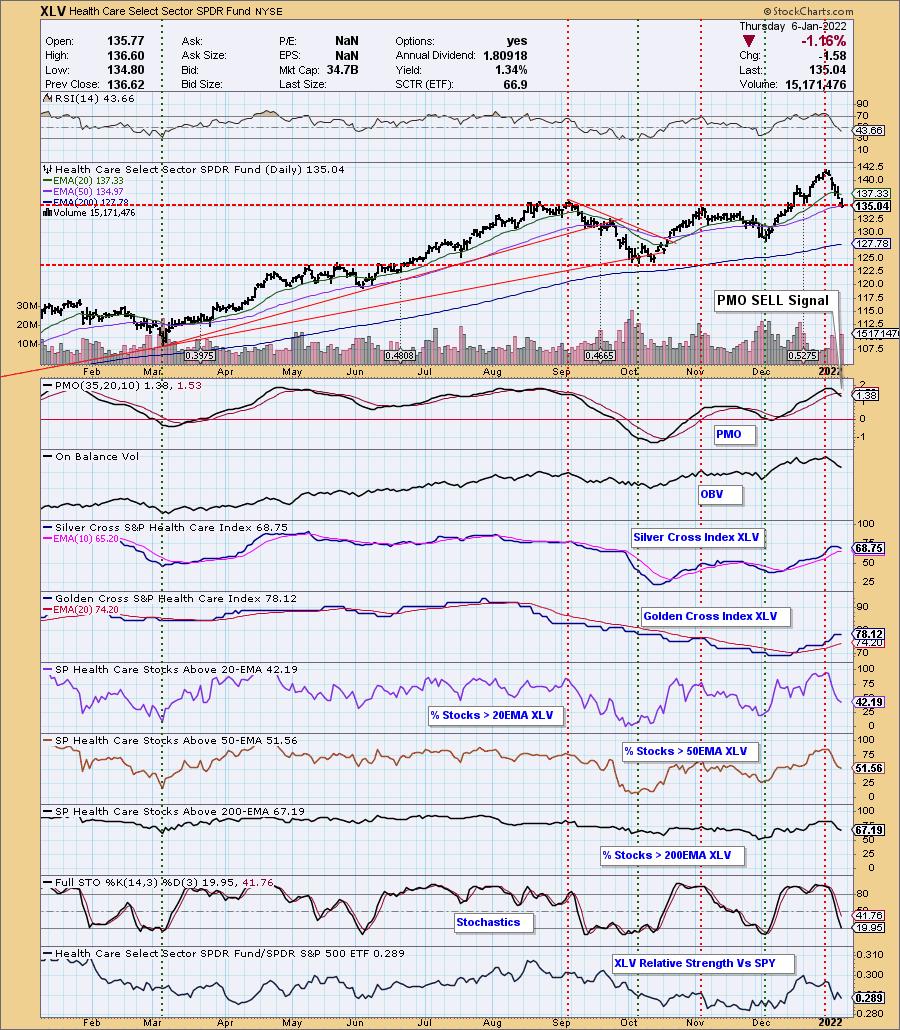

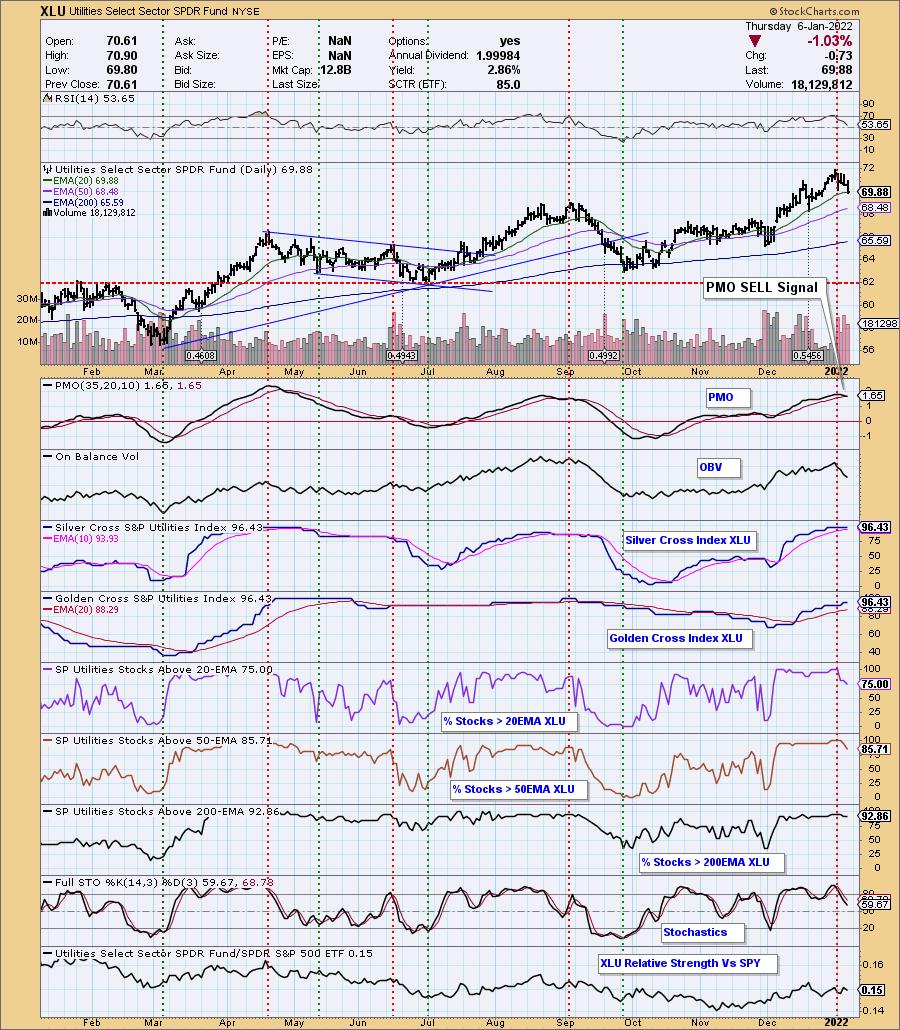
The DecisionPoint Alert Weekly Wrap presents an end-of-week assessment of the trend and condition of the Stock Market, the U.S. Dollar, Gold, Crude Oil, and Bonds. The DecisionPoint Alert daily report (Monday through Thursday) is abbreviated and gives updates on the Weekly Wrap assessments.
Watch the latest episode of DecisionPoint on StockCharts TV's YouTube channel here!
MAJOR MARKET INDEXES
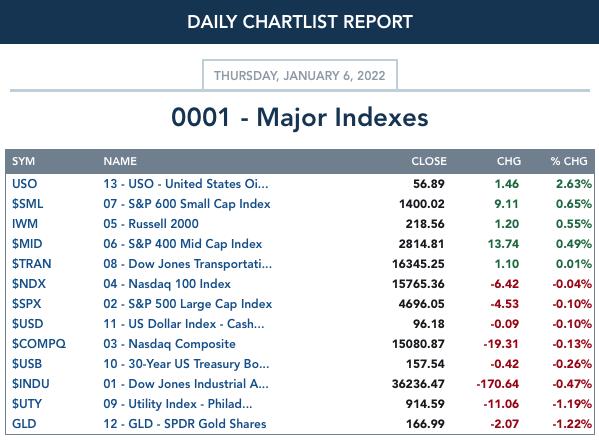
SECTORS
Each S&P 500 Index component stock is assigned to one, and only one, of 11 major sectors. This is a snapshot of the Intermediate-Term (Silver Cross) and Long-Term (Golden Cross) Trend Model signal status for those sectors.
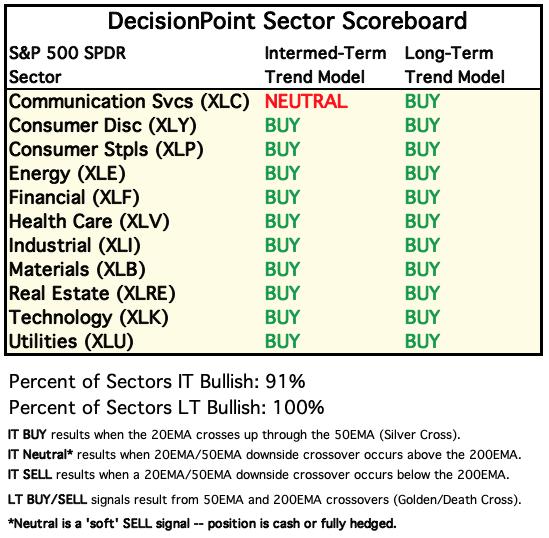
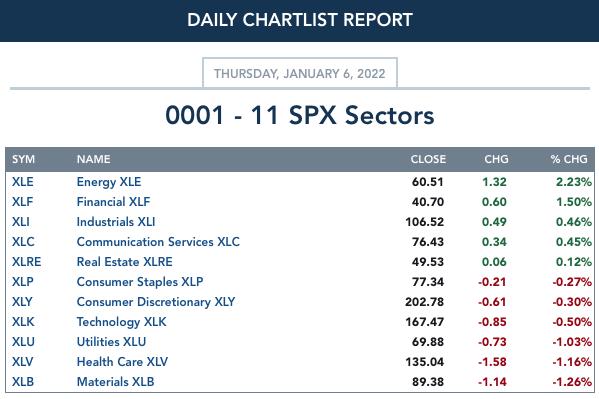
RRG® Chart: Strongest sectors are XLE and XLB which are the only two sectors in "Leading" with both having a bullish northeast heading. Next up would be XLI and XLF which are overlapping as they travel toward Leading out of Improving. Interestingly, all of the defensive sectors are Weakening despite uncertainty in the market. XLP is now headed back to Leading while the others continue to head southwest or in the case of XLU, northwest. XLK is the weakest off all of the sectors as it travels in the bearish southwest direction. XLY looks fairly good as it makes its way toward Leading again.
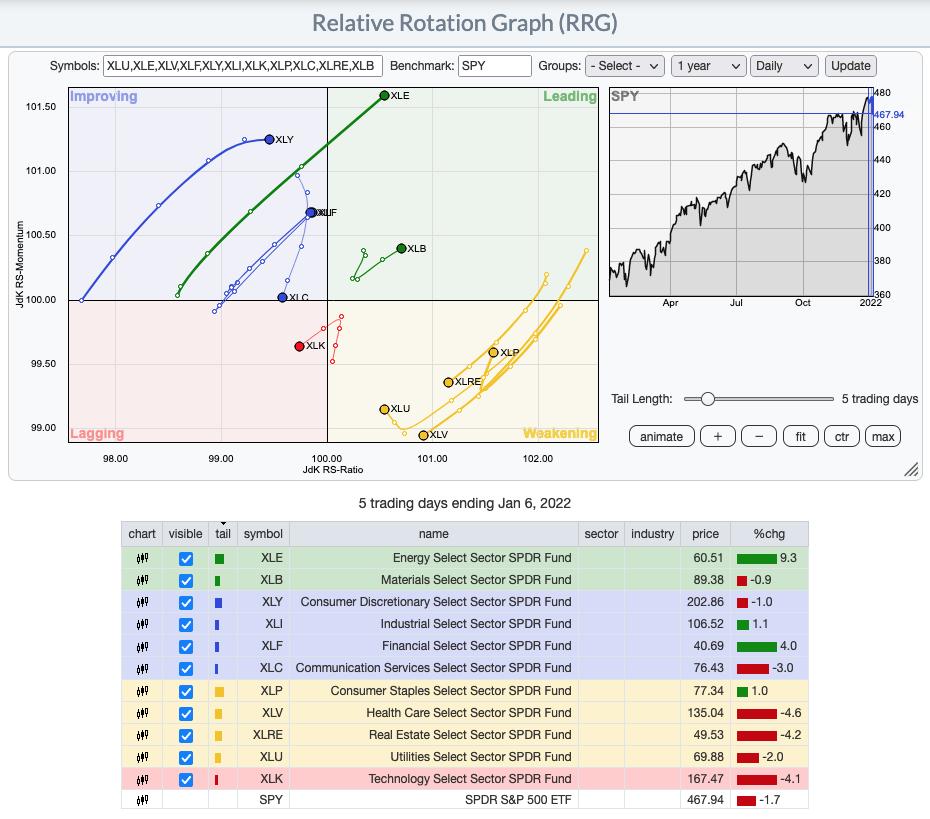
RRG® charts show you the relative strength and momentum for a group of stocks. Stocks with strong relative strength and momentum appear in the green Leading quadrant. As relative momentum fades, they typically move into the yellow Weakening quadrant. If relative strength then fades, they move into the red Lagging quadrant. Finally, when momentum starts to pick up again, they shift into the blue Improving quadrant.
CLICK HERE for an animated version of the RRG chart.
CLICK HERE for Carl's annotated Sector charts.
THE MARKET (S&P 500)
IT Trend Model: BUY as of 10/18/2021
LT Trend Model: BUY as of 6/8/2020
SPY Daily Chart: The market finished mostly unchanged today as it digested yesterday's decline. However, we set lower lows and lower highs on today's candlestick. The indicators are shifting bearish. Tomorrow we will see a PMO crossover SELL signal. The SPY will join the OEX and NDX which triggered SELL signals this week.
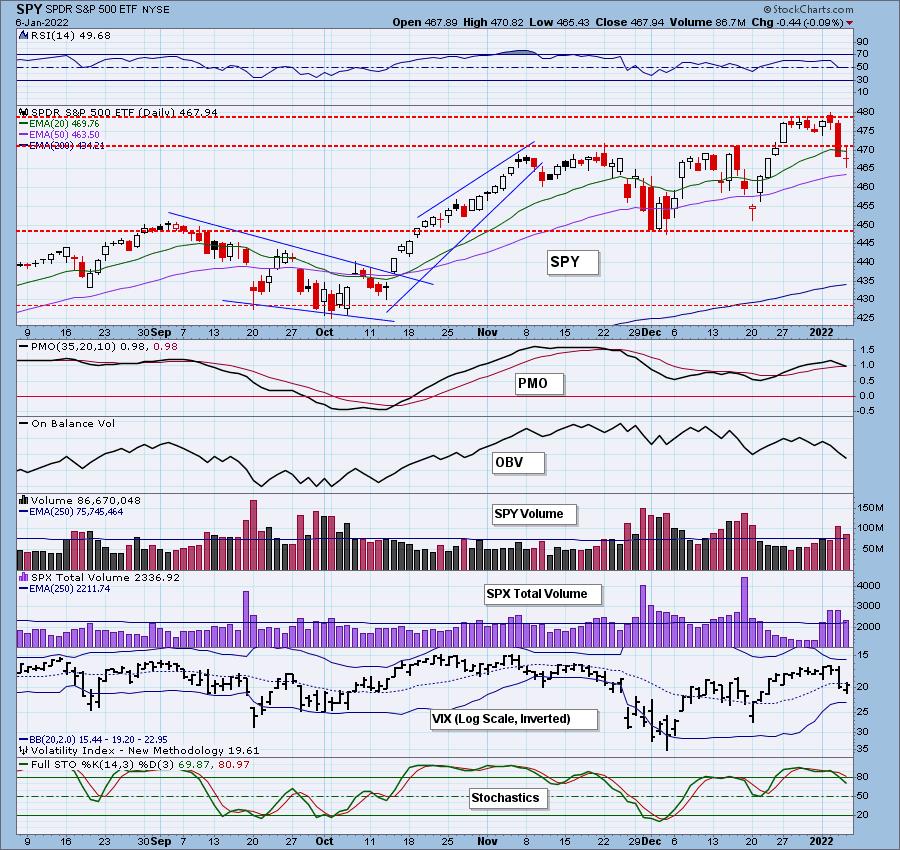
The RSI is now in negative territory below net neutral (50). It also appears that the negative OBV divergence is playing out. Total Volume was elevated above its annual average, but pulled back significantly from yesterday.
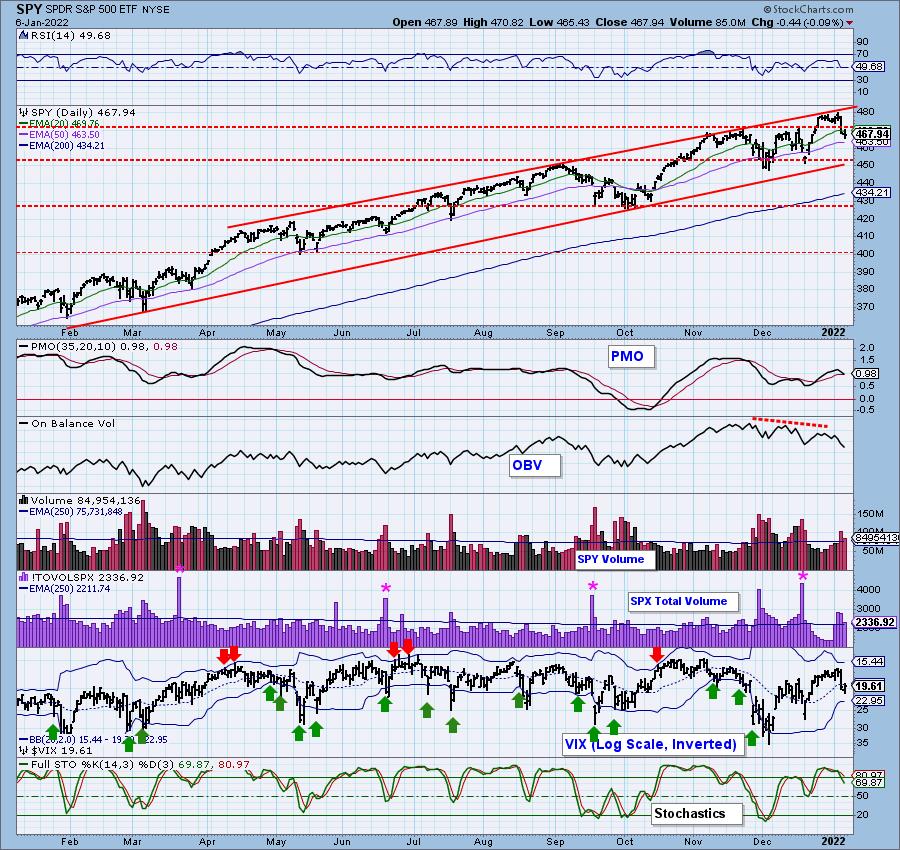
PARTICIPATION: The following chart objectively shows the depth and trend of participation in two time frames.
- Intermediate-Term - the Silver Cross Index (SCI) shows the percentage of SPX stocks on IT Trend Model BUY signals (20-EMA > 50-EMA). The opposite of the Silver Cross is a "Dark Cross" -- those stocks are, at the very least, in a correction.
- Long-Term - the Golden Cross Index (GCI) shows the percentage of SPX stocks on LT Trend Model BUY signals (50-EMA > 200-EMA). The opposite of a Golden Cross is the "Death Cross" -- those stocks are in a bear market.
The SCI turned down today and is about to lose its bullish value above 70%. The GCI is bullish at 81% and it is rising which is bullish for the long term.
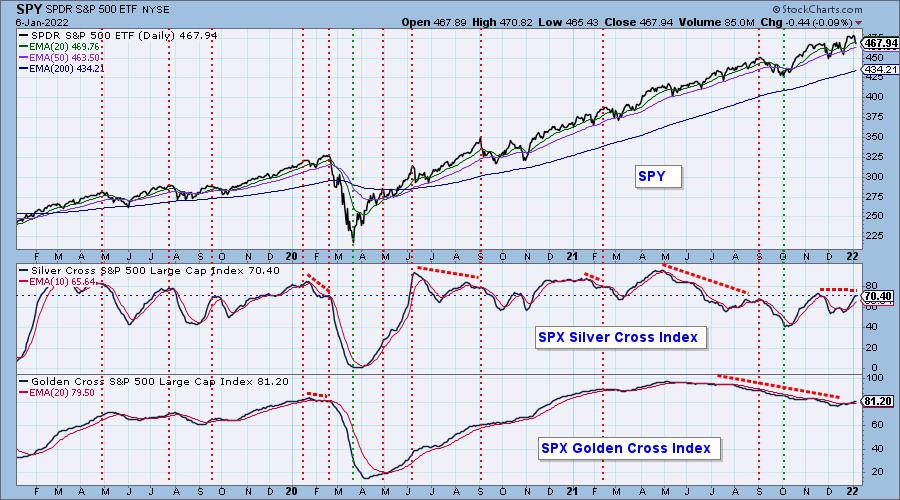
S&P 500 New 52-Week Highs/Lows: New Highs contracted again today which isn't a surprise. The 10-DMA of the High-Low Differential is still rising, but is starting to look toppy.
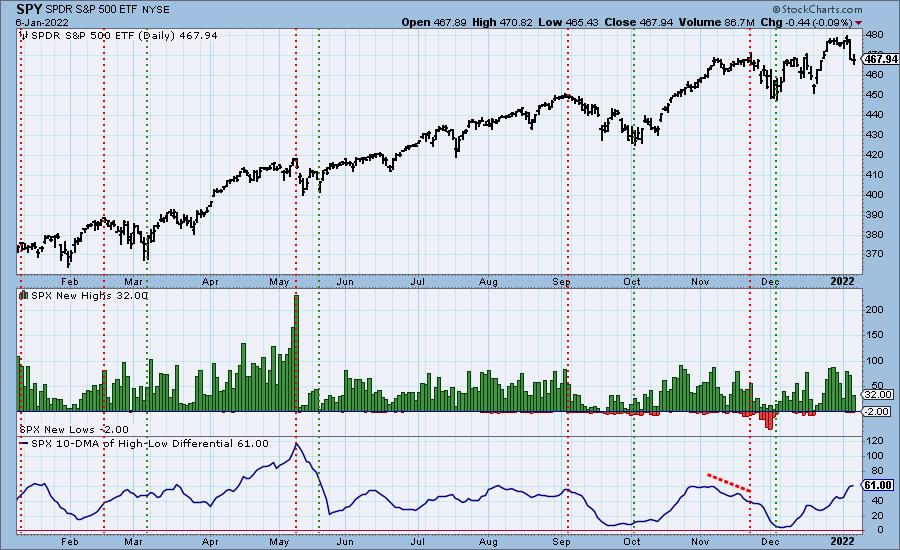
Climax* Analysis: No climax today. Bollinger Bands on the VIX are squeezing so we could see a bullish puncture of the lower Band on our inverted scale. Those punctures generally lead to upside reversals, but we're not there yet.
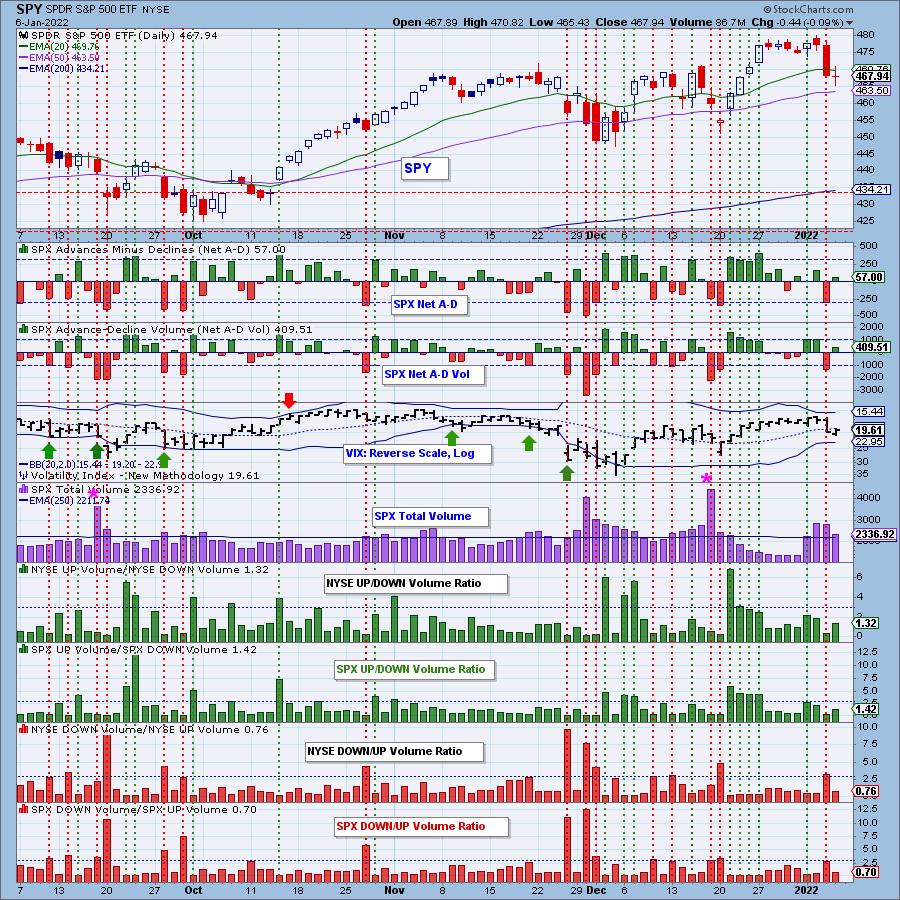
*A climax is a one-day event when market action generates very high readings in, primarily, breadth and volume indicators. We also include the VIX, watching for it to penetrate outside the Bollinger Band envelope. The vertical dotted lines mark climax days -- red for downside climaxes, and green for upside. Climaxes indicate either initiation or exhaustion.
Short-Term Market Indicators: The short-term market trend is UP and the condition is NEUTRAL.
STOs were mixed today with the STO-V rising slightly while the STO-B continued lower. Participation thinned a bit more today.
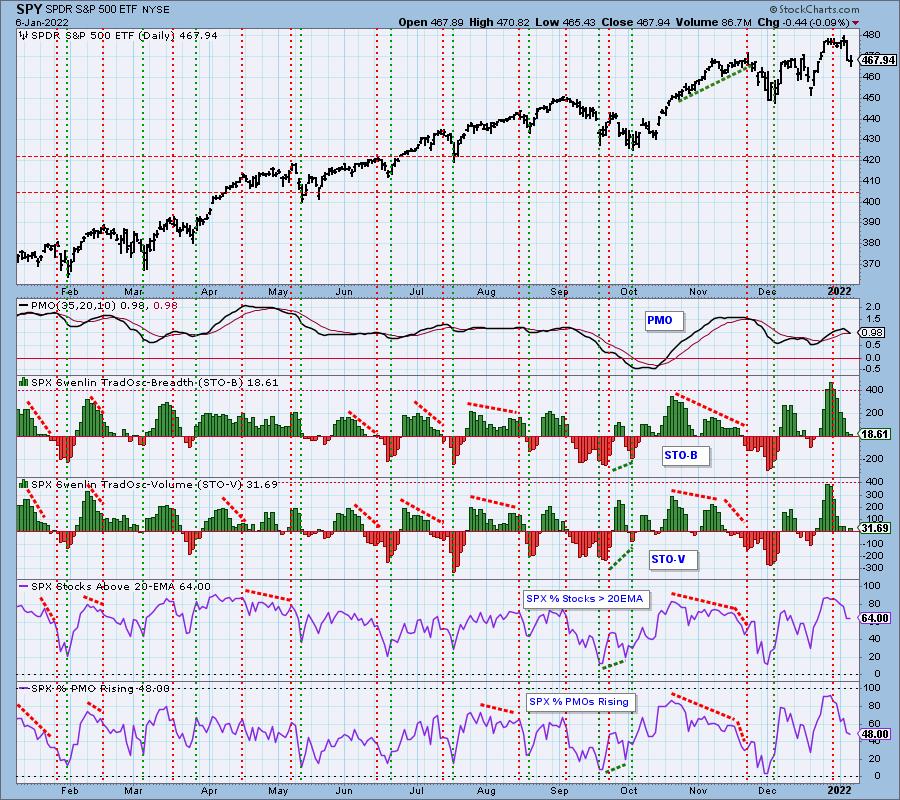
Intermediate-Term Market Indicators: The intermediate-term market trend is UP and the condition is OVERBOUGHT.
Like the STOs, the ITBM and ITVM were also mixed with the "volume" indicators moving higher, but the breadth indicators moving lower. Either way, negative divergences are still a problem and we are seeing shrinking participation of stocks with PMO BUY signals. That indicator is also moving down from overbought territory. None of these indicators can be considered oversold.
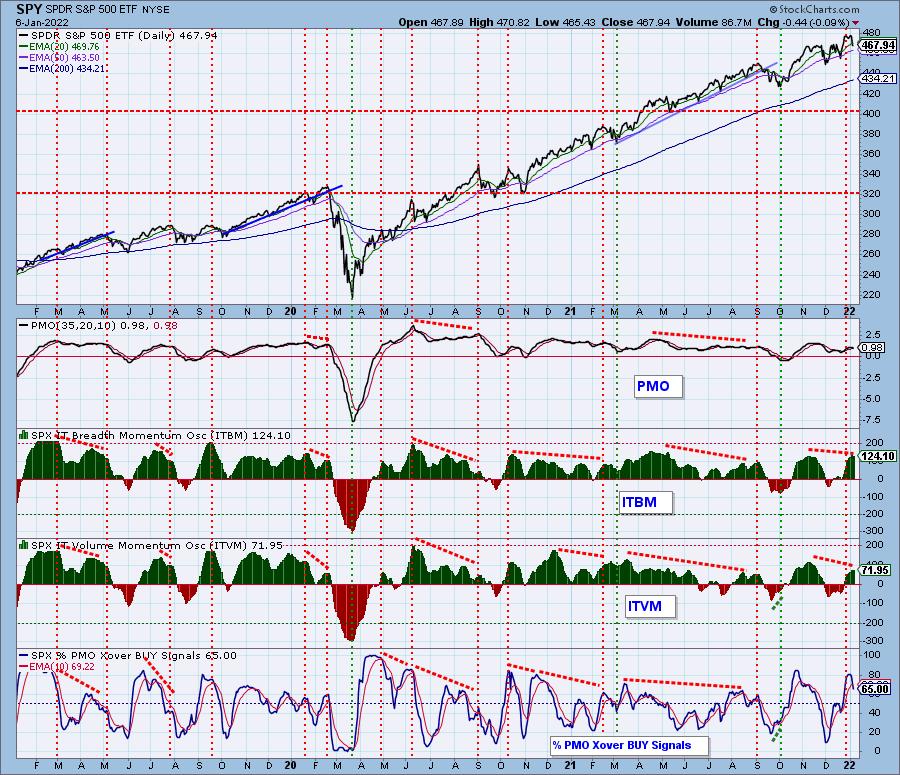
Bias Assessment: Participation of stocks > 20/50-day EMAs was flat today. Both percentages are lower than the SCI so we have a bearish short-term bias. The SCI having topped gives us a bearish intermediate-term bias. Long-term is still somewhat healthy, but we do see some deterioration of participation of stocks > 200-day EMAs. That percentage is also slightly lower than the GCI. I would still consider our long-term bias to be bullish.
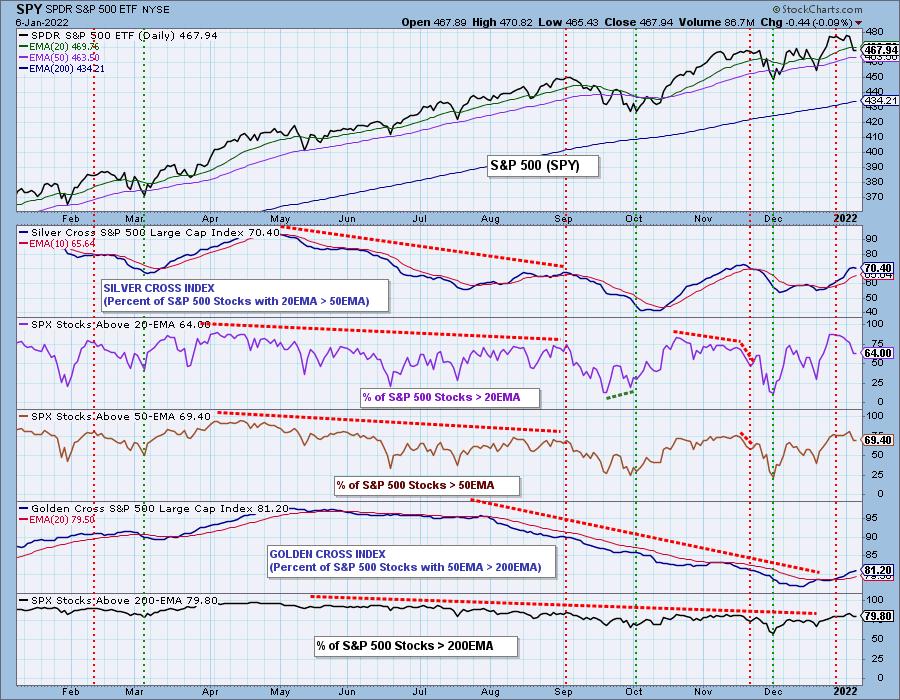
CONCLUSION: The market basically digested yesterday's decline. The nearing PMO SELL signal and the bearish bias in the short and intermediate terms are a big problem. It tells me to limit my exposure or exercise caution when adding positions. At this point, rising rates seem to be benefiting Financials and Energy is surging higher. Moving from growth to value should help protect you, but if this decline accelerates, even those stocks will be vulnerable to a decline.
I'm 10% exposed the market with the remainder in cash and readily available to trade with.
Have you subscribed the DecisionPoint Diamonds yet? DP does the work for you by providing handpicked stocks/ETFs from exclusive DP scans! Add it with a discount! Contact support@decisionpoint.com for more information!
BITCOIN
Yesterday's comments still apply:
"We'd been expecting a test of $42,500 on Bitcoin. Indicators are very negative and are showing no signs of improvement. It's now time to contemplate a drop to $30,000."
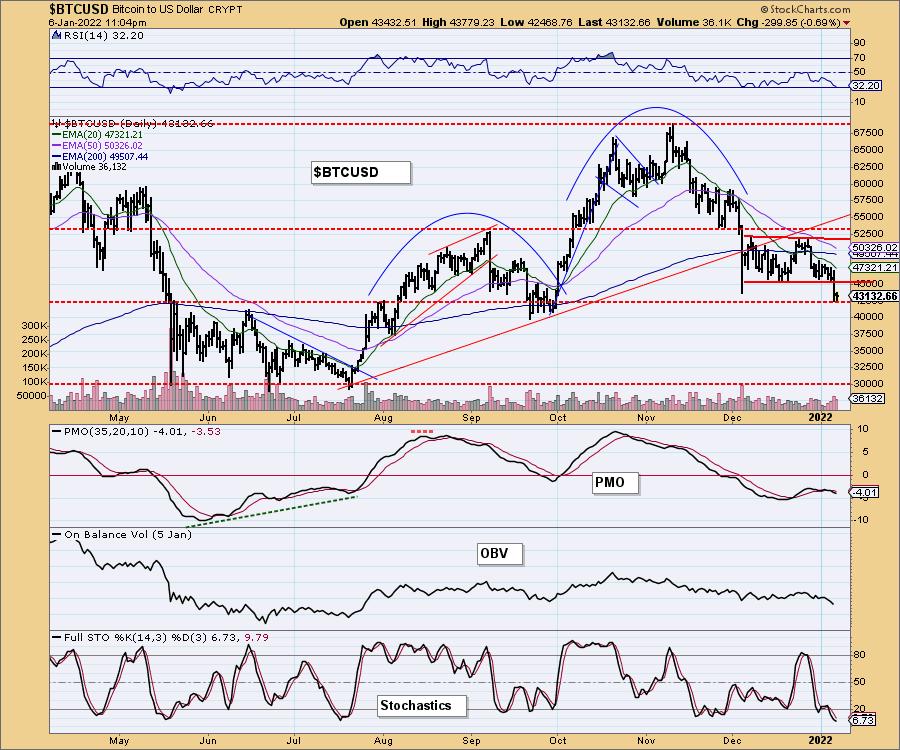
INTEREST RATES
Long-term interest rates continue to move higher. Long-term rates are ready to challenge the October highs.
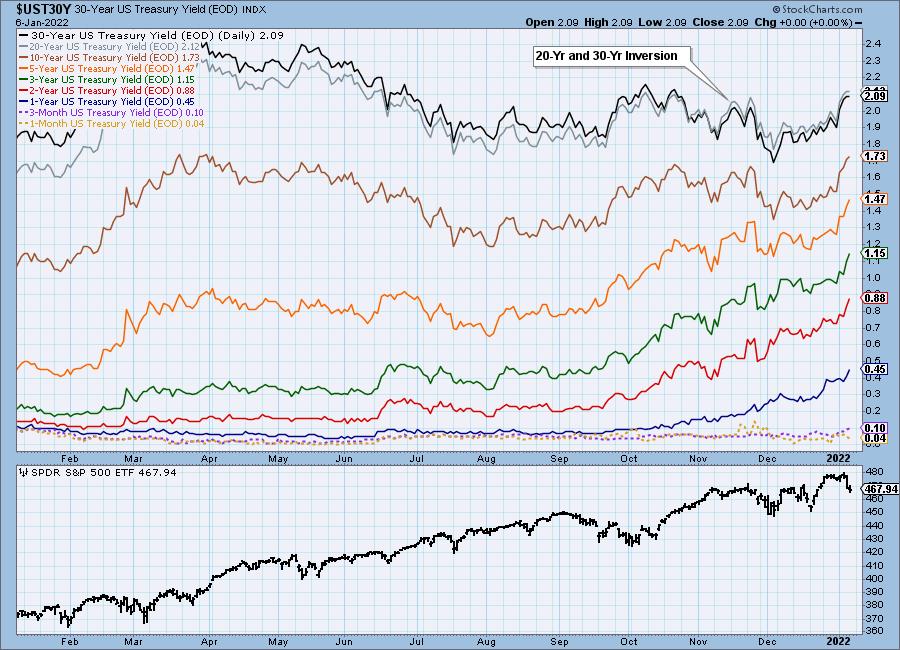
10-YEAR T-BOND YIELD
The 10-year yield continues to push higher and will be testing overhead resistance at the March high. The RSI is beginning to get overbought, but you'll note back in February and March it wasn't much of a problem. The PMO is very bullish and Stochastics are now above 80. We would look for a breakout above March rates.
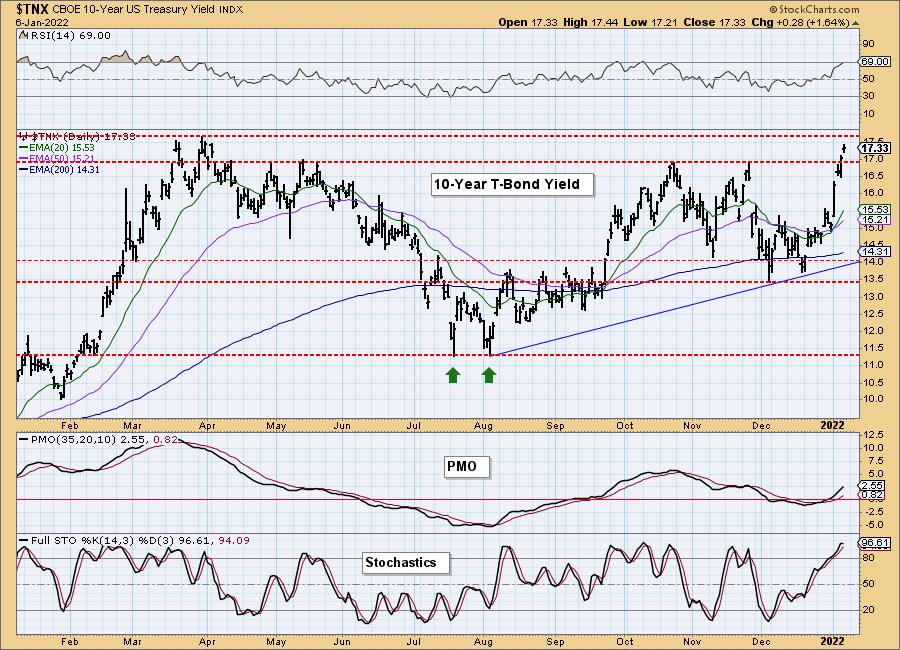
DOLLAR (UUP)
IT Trend Model: BUY as of 6/22/2021
LT Trend Model: BUY as of 8/19/2021
UUP Daily Chart: The Dollar is now traveling within a bearish descending triangle (flat bottoms, declining tops). The PMO is flat and while the RSI is positive, its moving sideways in neutral territory. Stochastics do look interesting, but they are decelerating already.

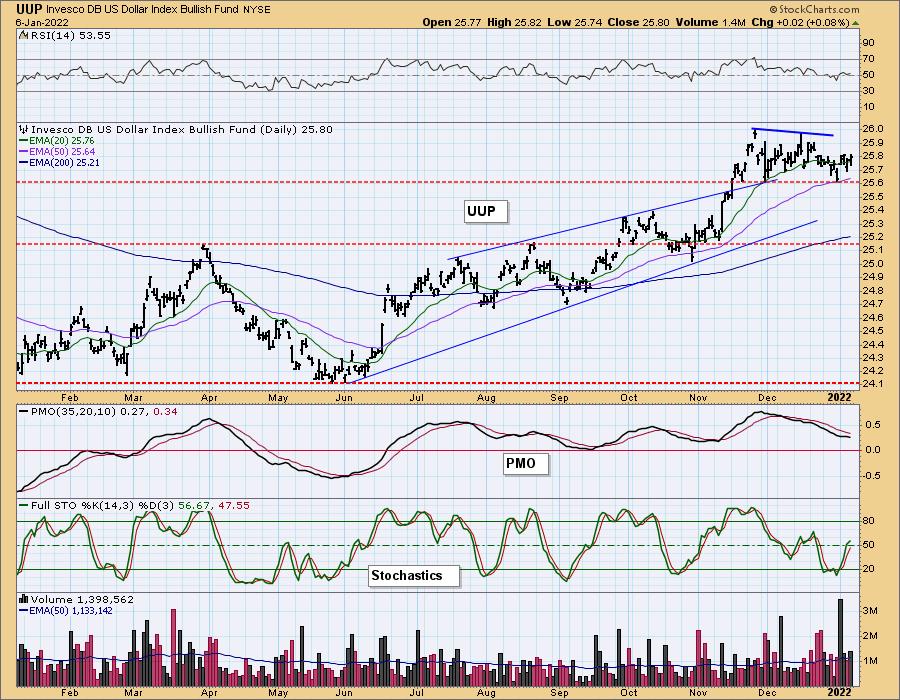
GOLD
IT Trend Model: BUY as of 12/29/2021
LT Trend Model: SELL as of 12/3/2021
GLD Daily Chart: The bearish rising wedge that we pointed out yesterday was confirmed with today's decline. It is holding above support at the mid-December low, late August lows and early September lows. While this looks like it could be sturdy, indicators are very bearish with the RSI now negative and the PMO topping. Stochastics are very bearish as well. This support level won't likely hold.
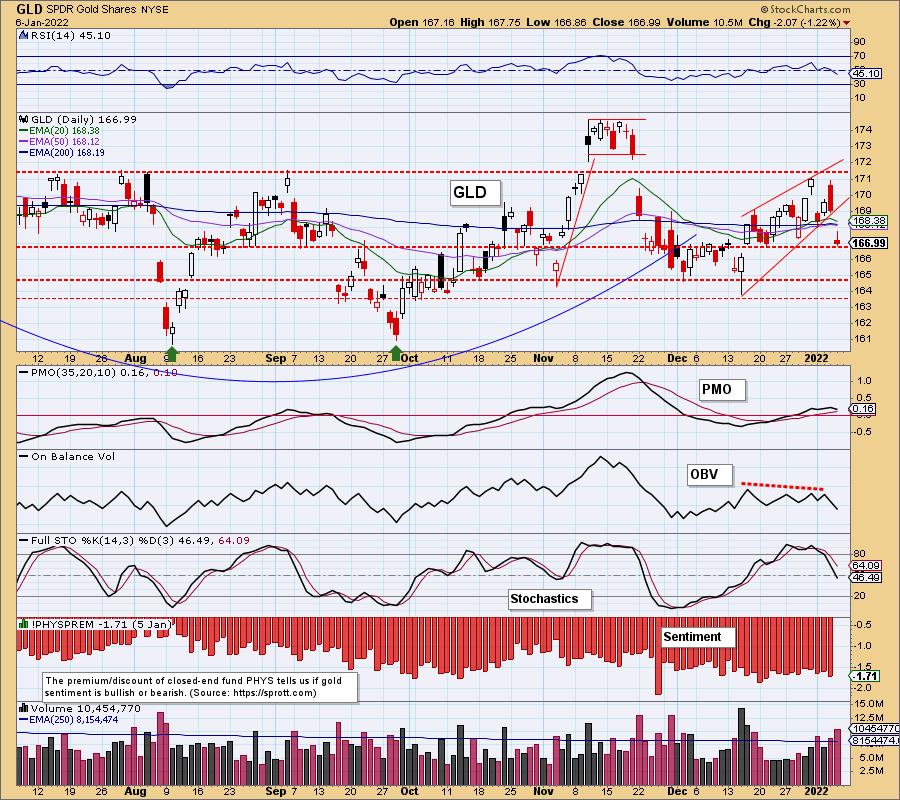
GOLD Daily Chart: If we're looking for the next support level for $GOLD, I would point to the November/December lows around $1760.
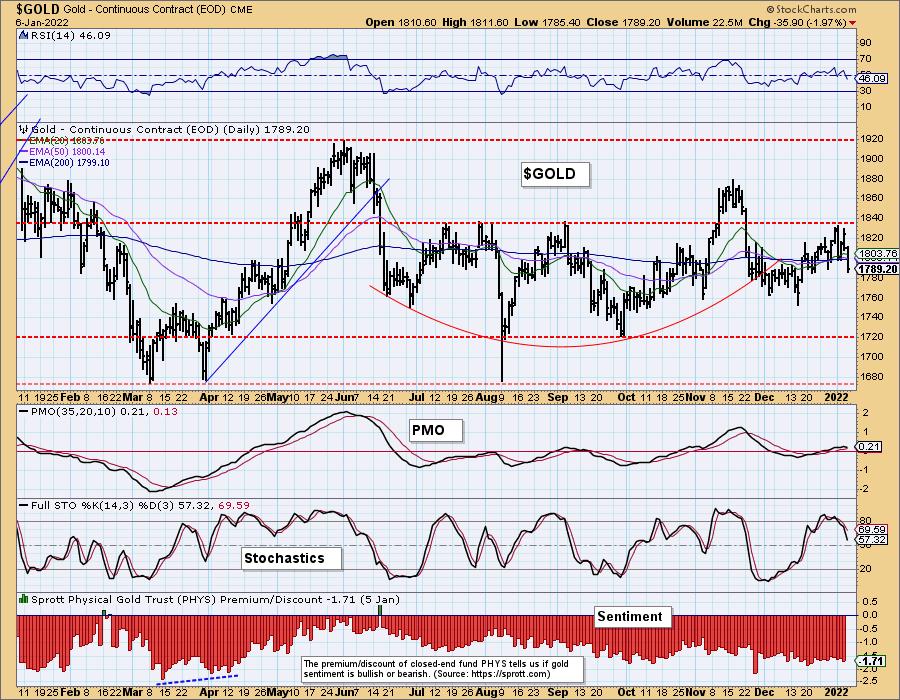
GOLD MINERS Golden and Silver Cross Indexes: GDX gapped down today just like GLD. We have been seeing deterioration "under the hood" so this isn't a surprise. The PMO is now headed for a crossover SELL signal below the zero line. The bright spot would be that indicators are getting oversold, but not enough to start looking for a reversal, particularly since support was lost at the March/August lows.
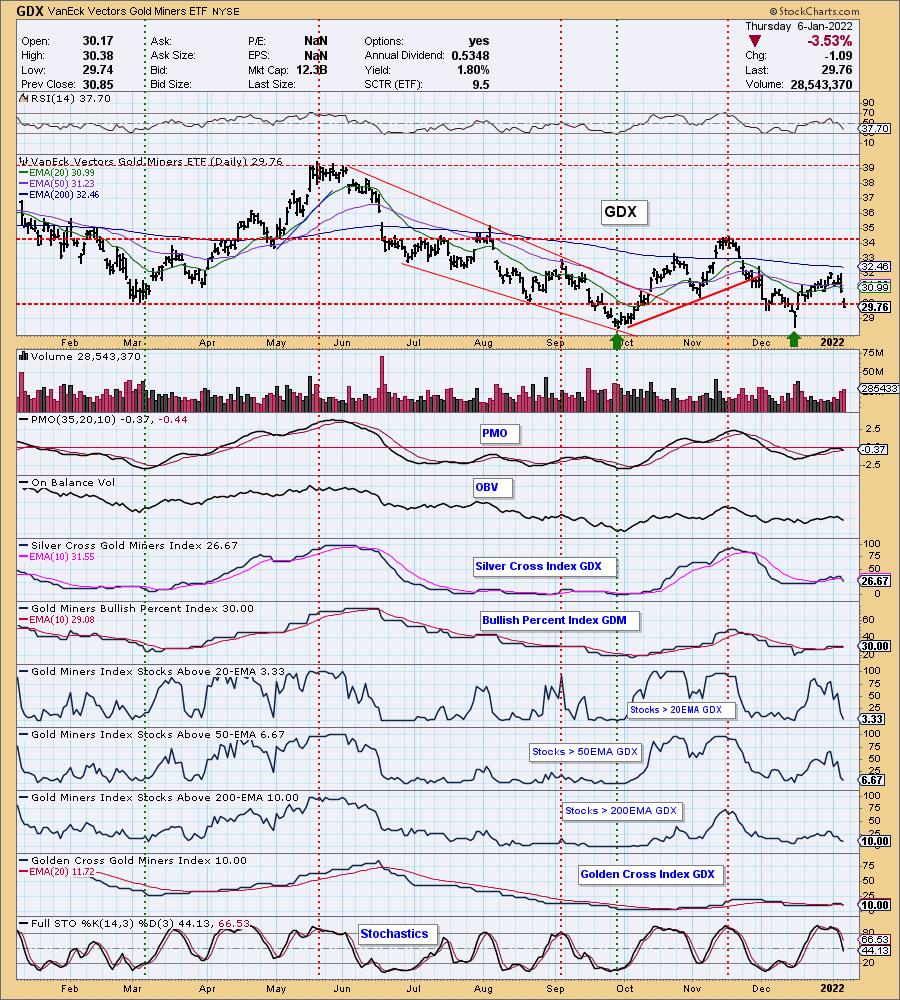
CRUDE OIL (USO)
IT Trend Model: BUY as of 1/3/2022
LT Trend Model: BUY as of 3/9/2021
USO Daily Chart: A rising wedge is bearish, but USO broke out above the pattern. This is especially bullish and suggests to me we will see a test of the October highs. The indicators are all in agreement. The RSI is positive, rising and not yet overbought. The PMO is rising on an oversold BUY signal and is not overbought. Stochastics are oscillating above 80 which suggests internal strength.
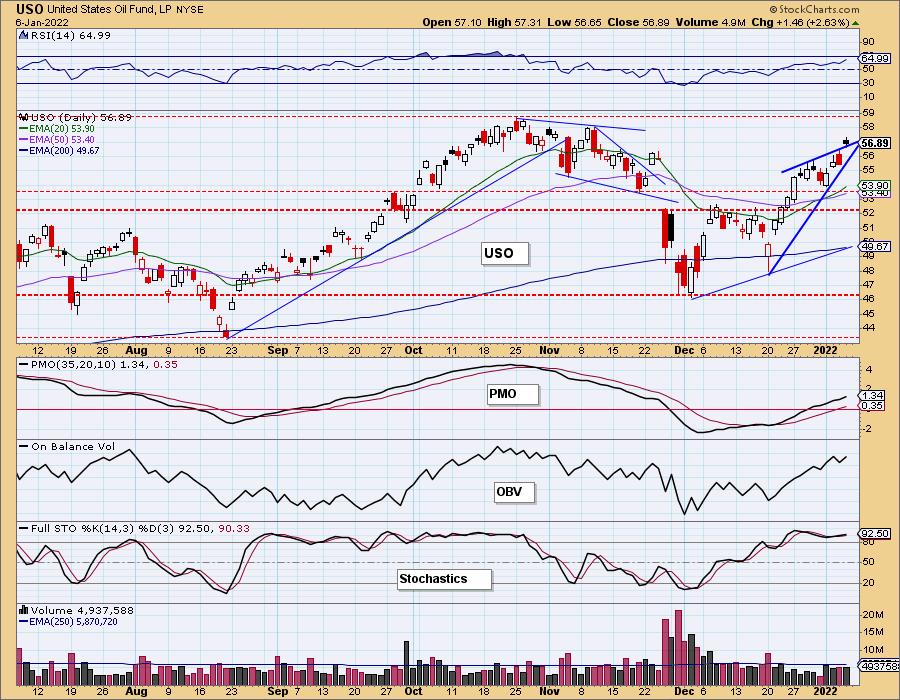

BONDS (TLT)
IT Trend Model: NEUTRAL as of 1/5/2022
LT Trend Model: BUY as of 11/5/2021
TLT Daily Chart: TLT picked up a quarter of a percent, but it wasn't enough to change the outlook. The PMO and RSI are still negative. Stochastics did turn up, but I won't consider them bullish until they are rising past 50.
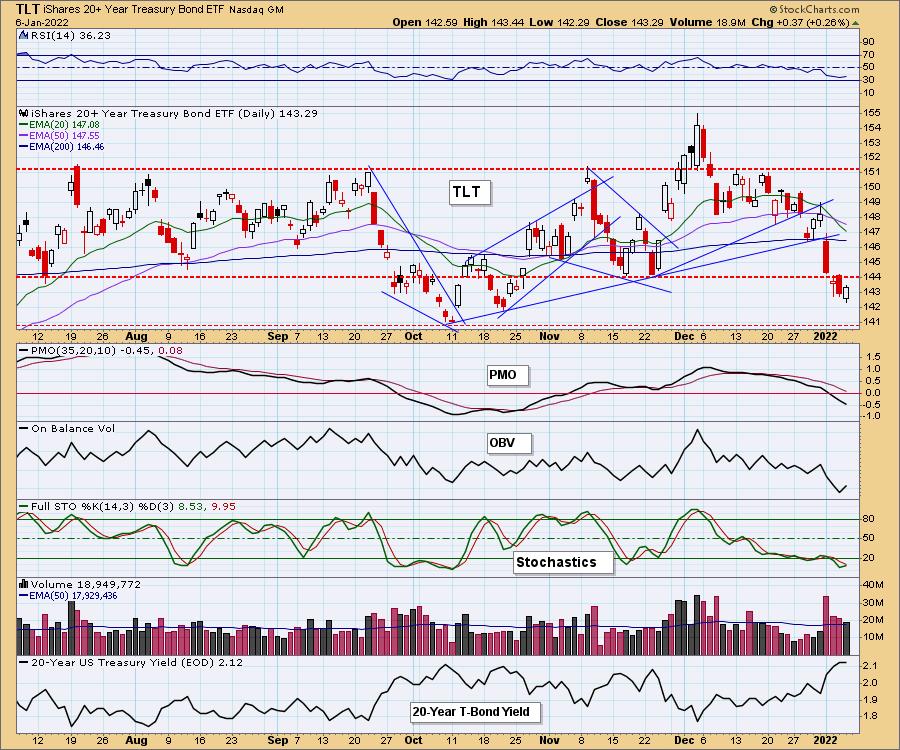
The long-term rising trend has been compromised this week so we would look for a drop that would test support at $140.
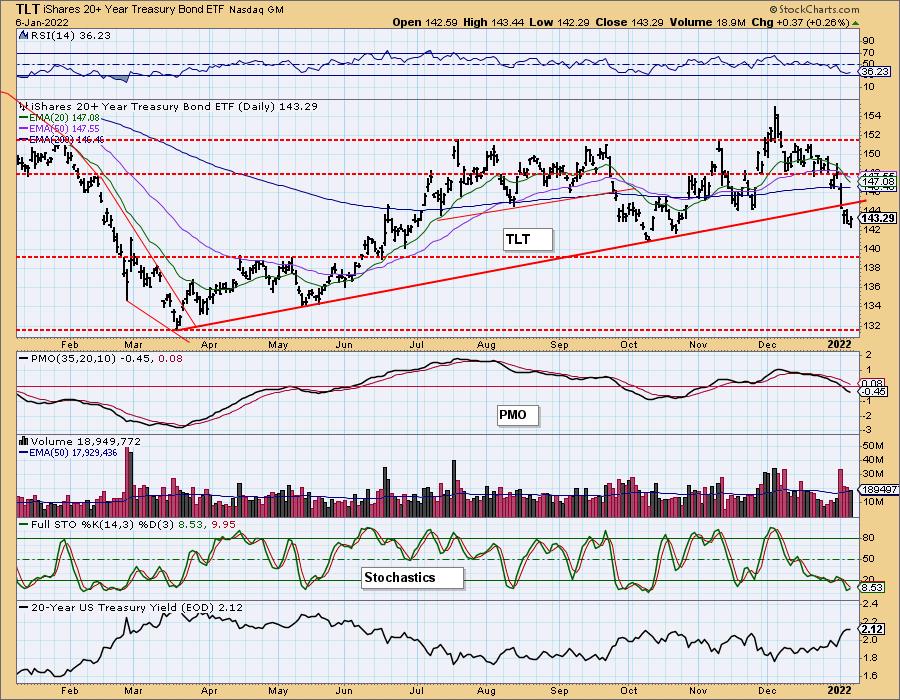
Happy Charting!
Erin Swenlin
Technical Analysis is a windsock, not a crystal ball. --Carl Swenlin
(c) Copyright 2022 DecisionPoint.com
Disclaimer: This blog is for educational purposes only and should not be construed as financial advice. The ideas and strategies should never be used without first assessing your own personal and financial situation, or without consulting a financial professional. Any opinions expressed herein are solely those of the author, and do not in any way represent the views or opinions of any other person or entity.
NOTE: The signal status reported herein is based upon mechanical trading model signals, specifically, the DecisionPoint Trend Model. They define the implied bias of the price index based upon moving average relationships, but they do not necessarily call for a specific action. They are information flags that should prompt chart review. Further, they do not call for continuous buying or selling during the life of the signal. For example, a BUY signal will probably (but not necessarily) return the best results if action is taken soon after the signal is generated. Additional opportunities for buying may be found as price zigzags higher, but the trader must look for optimum entry points. Conversely, exit points to preserve gains (or minimize losses) may be evident before the model mechanically closes the signal.
Helpful DecisionPoint Links:
DecisionPoint Alert Chart List
DecisionPoint Golden Cross/Silver Cross Index Chart List
DecisionPoint Sector Chart List
Price Momentum Oscillator (PMO)
Swenlin Trading Oscillators (STO-B and STO-V)
DecisionPoint is not a registered investment advisor. Investment and trading decisions are solely your responsibility. DecisionPoint newsletters, blogs or website materials should NOT be interpreted as a recommendation or solicitation to buy or sell any security or to take any specific action.
